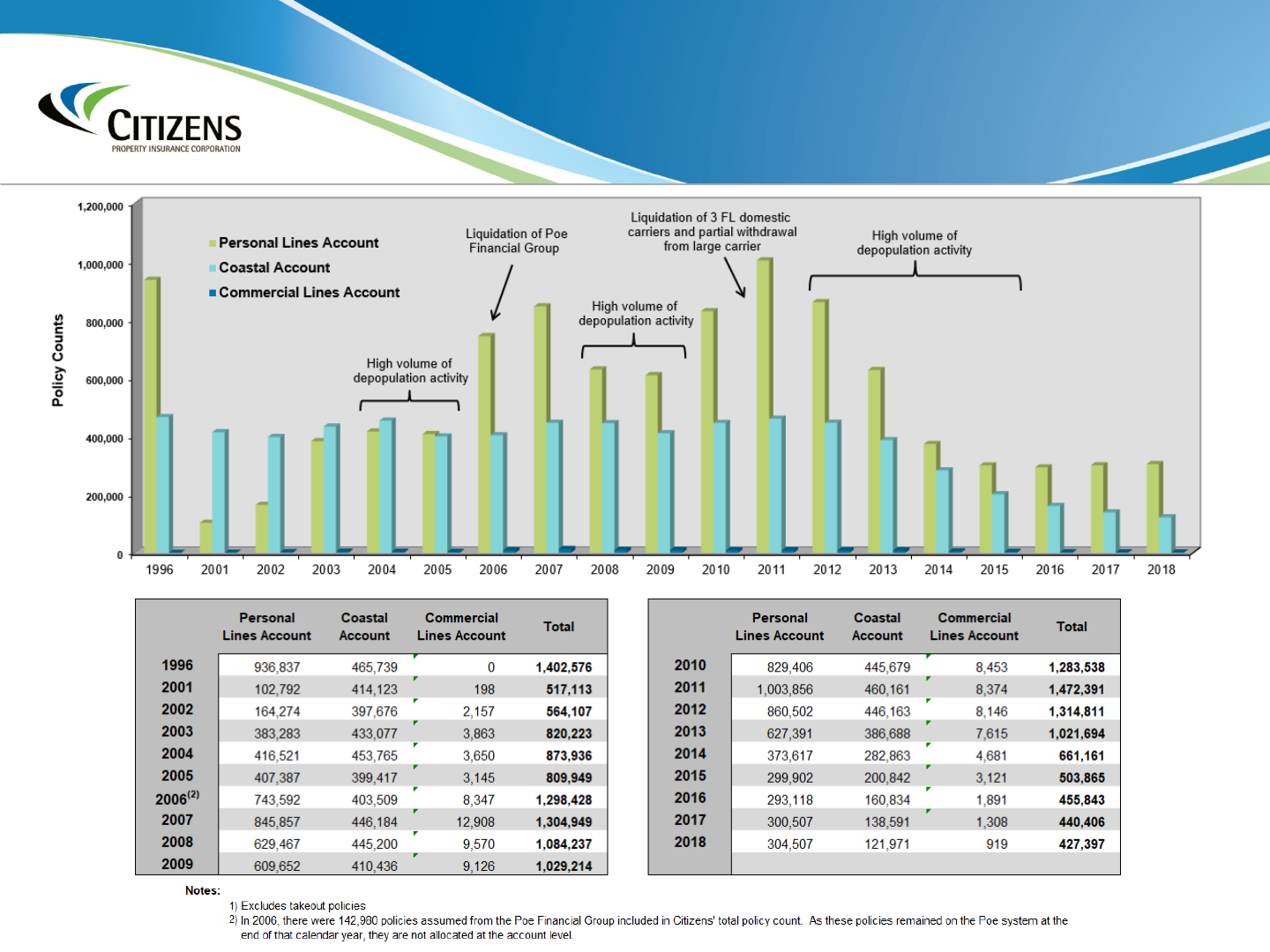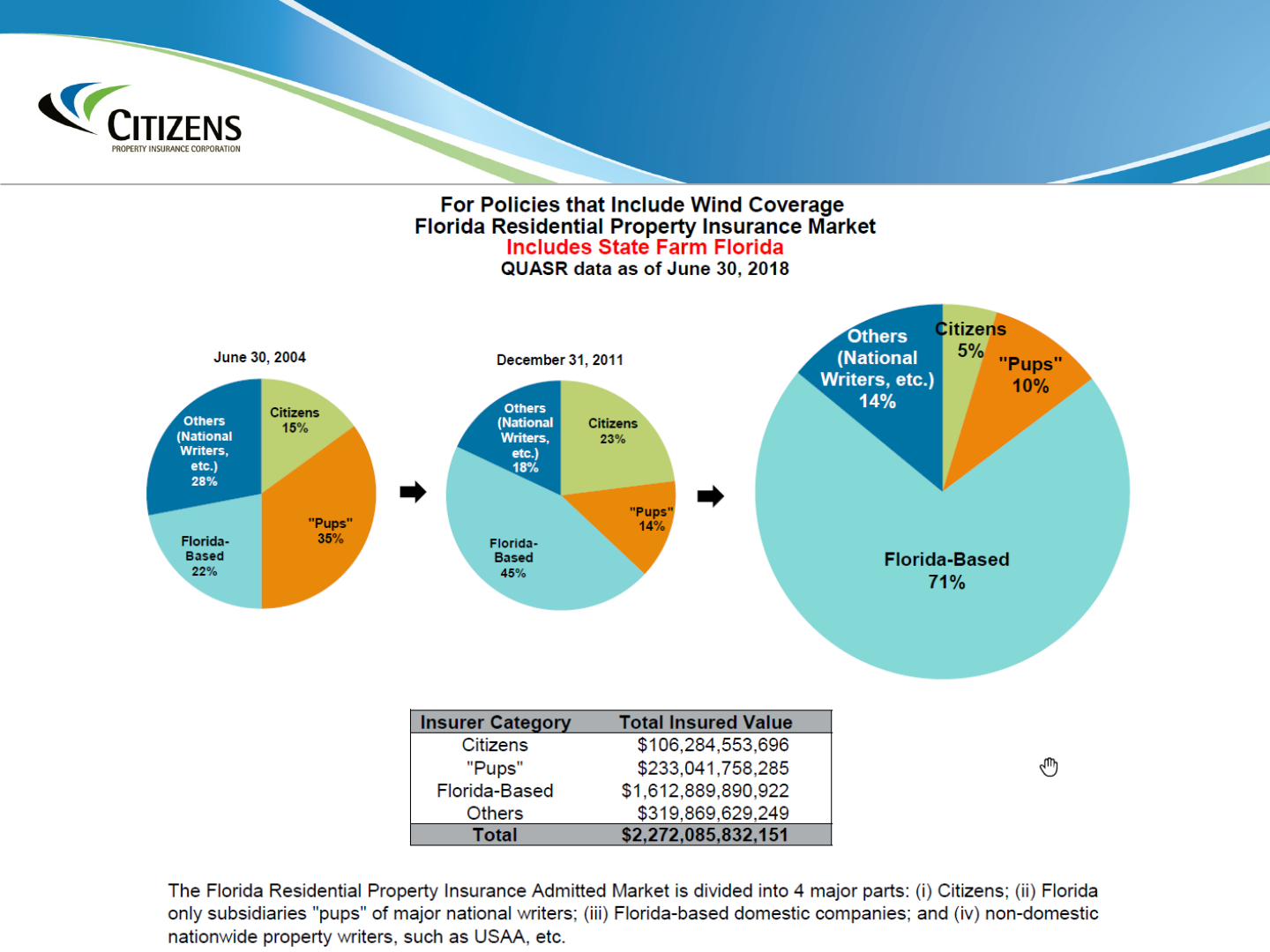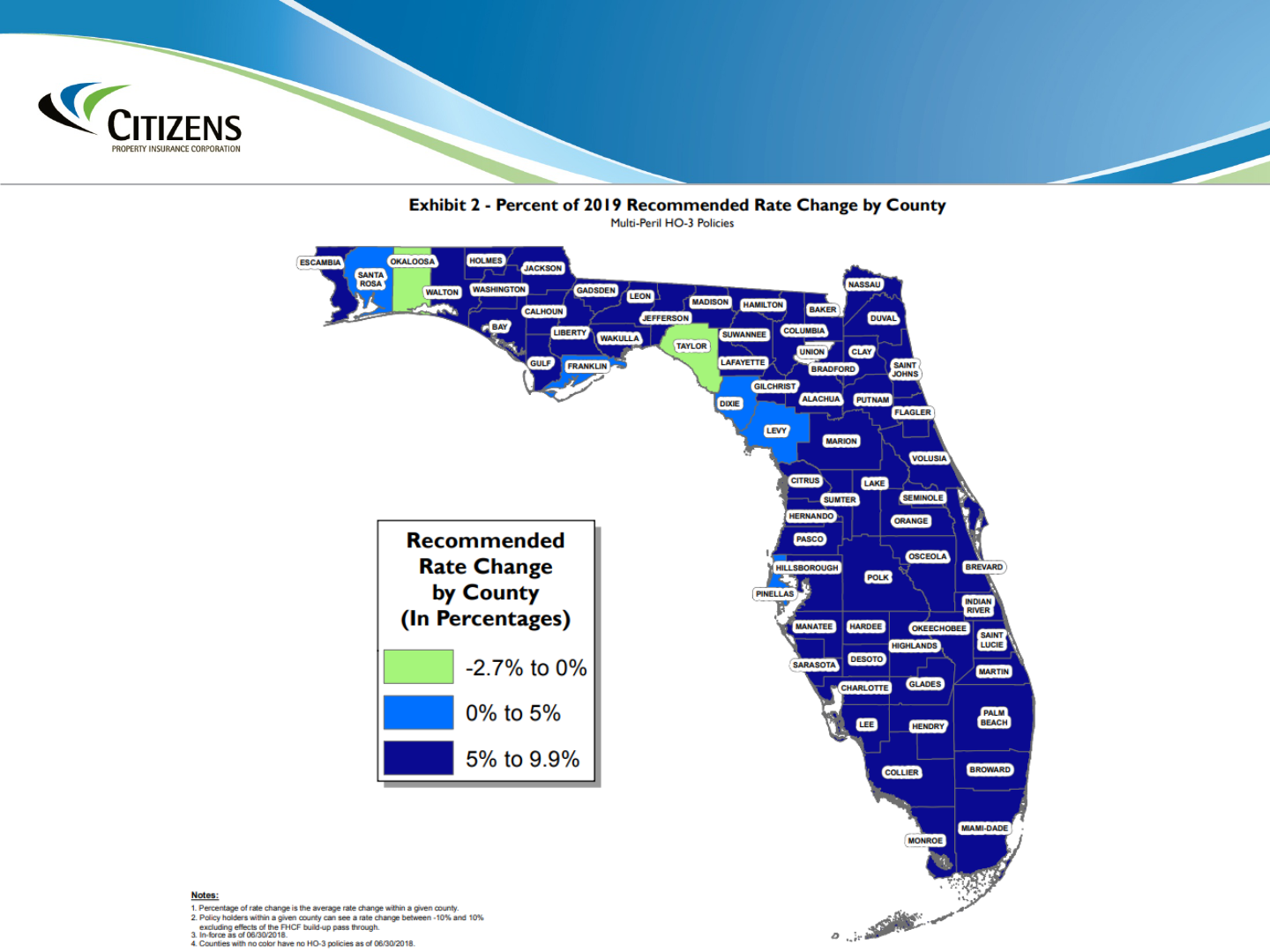
Citizens Property Insurance Corporation
Overview
Christine Ashburn
Chief – Communications, Legislative and External Affairs

• A state-created, not-for-profit, tax-exempt government entity whose public purpose is to
provide property insurance coverage to those unable to find coverage in the voluntary
admitted market or if coverage in the voluntary admitted market is more than 15% higher
than coverage with Citizens
• Created from the merger of the Florida Windstorm Underwriting Association (FWUA) and the
Florida Residential Property and Casualty Joint Underwriting Association (FRPCJUA)
• FWUA: created in 1972 as insurer of last resort to provide wind-only coverage in
Monroe County. The wind-only territories of the FWUA were expanded over time to
include most coastal regions
• FRPCJUA created in 1992 following Hurricane Andrew as an insurer of last resort for
areas of the state not covered by the FWUA
• Governed by a nine member board of Governors, three of whom are appointed by the
Governor and two of whom are each appointed by the Chief Financial Officer, Senate
President and Speaker of the House
• Operate pursuant to a plan of operation which is reviewed and approved by the Financial
Services Commission
• Subject to regulation by the Florida Office of Insurance Regulation (OIR), Operational Reviews
by the Auditor General and OIR Market Conduct Examiners, and external audits
• Citizens also has a robust Office of Internal Audit and an Inspector General
Page 2
Overview

When Citizens was created, each of the predecessor organizations had slightly different coverage
offerings and outstanding indebtedness, requiring the premium associated with each to remain
aligned.
Each of the following three accounts are separate are statutory accounts and have separate
calculations of surplus, plan-year deficit and assessment bases. Assets in one account many not
be comingled or used to fund losses in another account. The three accounts are listed below with
the types of policies written in each.
Personal Lines Account (PLA)
• Personal Residential Multiperil policies, including homeowners, dwelling fire, mobile home,
tenants and condominium unit owners, These policies tend to be located further inland or in
non-coastal areas of the state
Coastal Account (Formerly High Risk Account)
• Wind-only and multiperil policies for personal residential, commercial residential and
commercial nonresidential risks located in eligible coastal high risk areas
Commercial Lines Account (CLA)
• Commercial Residential Multiperil policies, including condominium associations, apartment
buildings and homeowners association policies
• Commercial Nonresidential Multiperil policies located outside of the coastal (HRA) eligible
areas
Page 3
Overview

• Under Florida law, Citizens may write a new insurance policy only for property that meets one
of the following eligibility criteria:
• Coverage is not available from a Florida-authorized insurance company
• Premiums for coverage from Florida-authorized insurance companies are more than
15 percent higher than the premiums for comparable coverage from Citizens
• In 2013 the legislature created a Property Insurance Clearinghouse to help identify private-
market insurance options for consumers who believe Citizens might be their only choice for
property insurance and to ensure that only customers who are eligible obtain coverage from
Citizens
• Citizens' Depopulation Program, authorized by Florida law, matches Citizens policyholders
with insurance companies interested in removing their policy from Citizens and providing
private-market coverage for their policy. All companies assuming policies from Citizens have
been approved by the Office of Insurance Regulation (OIR)
Page 4
Eligibility

Page 5
Policies In Force

Page 6
Market Share

Citizens has at its disposal both the traditional resources available to all property and
casualty companies that conduct business in the state as well as assessment powers
granted to Citizens by law.
Page 7
Financial Resources
Traditional Financial Resources
• Insurance Premiums
• Investment Income
• Operating Surplus from Prior Years
• Florida Hurricane Catastrophe Fund Reimbursements
• Traditional Reinsurance and Capital Markets Risk
Transfer
Unique Financial Resources
• Citizens’ Policyholder Surcharges
• Regular Assessments (Coastal only)
• Emergency Assessments
• Pre-event liquidity resources (debt issuances and lines of
credit which, if drawn upon, must be repaid)

Page 8
Assessments

Page 9
Assessments
• The 2005 Emergency
Assessment was
terminated for policies
issued or renewed
beginning on July 1,
2015
• Currently, no
assessments are being
levied by Citizens

Page 10
Financial Summary (in billions)
YTD
Q3-2018
2017 2016 Book of Business
Nov-2018
Change
Last Mth
Change
Last Yr
Surplus
1
100-YR PML
2
Claims-Paying Capacity
3
Total Cash and Invested Assets
$6.4
$4.9
$11.7
$9.5
$6.4
$5.2
$11.9
$10.1
$7.4
$6.0
$15.8
$12.1
Total Premium Inforce
Average Premium - PLA
Average Premium - Coastal
Average Premium - CLA
$866M
$1,711
$2,552
$16,435
-0.2%
0%
0%
-1%
-0.6%
6.3%
0.2%
3.7%
1
Accumulated Surplus is determined in accordance with Statutory Accounting Principles (SAP).
2
As of Q4-2014, Single-event occurrence Probable Maximum Loss ("PML“) includes demand surge, excludes storm surge, and does not include LAE.
3
Claims Paying Capacity consists of (1) 2018 Q3 Statutory Surplus, (2) risk transfer for 2018-19 hurricane season (including FHCF coverage), and (3) par
value of pre-event bonds. Please note that this figure shows resources on a combined basis. However, resources are specific to each account and may
not be used to fund needs in another account
Financial Overview
• While Citizens continues to have a healthy financial position, the PLA has had net losses
each year since 2015:
• Oct 2018 (unaudited): ($64,465,000)
• 2017 (audited): ($555,475,000)*
• 2016 (audited): ($35,017,000)
• 2015 (audited): ($21,489,000)
*Due to Hurricane Irma losses

Page 11
Public Summary of Citizens Assessment Reduction Efforts Over Time
Notes:
1. Storm Risk is as measured by 1-in-100 year probable maximum loss (PML) plus estimated loss adjustment expenses using the Florida Hurricane Catastrophe Fund (FHCF) account
allocation where PLA and CLA are combined. PLA/CLA combined PMLs are added to the Coastal PMLs to be consistent for surplus distribution. In general, the PMLs presented are
as projected at the beginning of storm season; with the exception of 2017 which is as of August 31, 2017.
2. Surplus and Assessments are as projected at beginning of storm season. Not all PLA/CLA surplus is needed to fund storm risk in 2014. In 2015 - 2018, not all surplus in PLA/CLA and
the Coastal Account is needed to fund storm risk. Remaining surplus is available to fund a second event.
3. Florida Hurricane Catastrophe Fund (FHCF) is as projected at beginning of storm season; with the exception of 2017 and 2018 which are Citizens' initial data submission to the FHCF.
4. Depopulation PMLs are not included in storm risk totals and are presented as year end totals; with the exception of 2018, which is as of May 31, 2018. PMLs from 2011-2014 use a
weighted average of 1/3 Standard Sea Surface Temperature (SSST) and 2/3 Warm Sea Surface Temperature (WSST). 2015 - 2018 PMLs reflect only SSST event catalog.
Storm Risk: 1 in 100 year PML

Hurricane Michael Claims
Statistics
Claims Summary Total Commercial Personal
New Claims 3,360 59 3,301
Closed Claims 2,442 39 2,403
% Closed 73% 66% 73%
Indemnity Paid $89,927,150 $7,664,979 $76,262,171
Expense Paid $1,972,680 $82,299 $1,890,381
Total Incurred $96,309,324 $7,852,144 $88,457,179
% Submitted by Self 79% 54% 79%
% Submitted by Rep 1% 12% 1%
% Submitted by Other 20% 34% 20%
% Storm Surge 5% 15% 5%
% AOB 1% 7% 1%
*As of 1-2-19
12

• Prior to 2007, rates were required to be non-competitive with the private market
• Rates for personal and commercial residential policies were frozen by statute from January 1,
2007 through December 31, 2009.
• Rates are now required to be actuarily sound, but not to exceed 10% increase annually per
policy, excluding the Florida Hurricane Catastrophe Fund Rapid Cash Build-Up Factor
• Citizens Board makes annual recommended rate changes to the Office of Insurance Regulation
(OIR) and they establish rates for Citizens.
• Citizens current average actuarial rate indication for multiperil homeowners is 25.2% with a
capped indication of 8.5%
• Actuarial rate need for homeowners multiperil policies ranges among House districts from
-3.5% to 56%
Page 13
Rates

Page 14
Homeowners Multiperil Rates

Page 15
Homeowners Wind-Only Rates

Page 16
Litigation

Available for Non-Weather Water Losses for Citizens’ HO-3 and DP-3 Policies
• Voluntary program offered at time of loss for water losses caused by accidental discharge or overflow of water or
steam from a plumbing, heating, air conditioning, automatic fire protective sprinkler system or household
appliance
• Emergency Water Removal Services
• No deductible
• No cost to policyholder even if loss is not covered by Citizens
• If the policyholder agrees to participate, Citizens provides a Citizens-approved contractor(s) to provide
water removal and drying services to protect insured structures from further damage
• Managed Repair Contractor Network Program
• Provides permanent repair services for covered damage
• Policyholder works with licensed and insured contractors within the network
• All contractors’ claim related work is guaranteed for three years
2018 Policy Changes
• Effective for HO-3 and dwelling DP-3 new business and renewals August 1, 2018
• $10,000 Sublimit for Coverages A and B if Managed Repair Contractor Network not used
• Requires all claimants other than insured, their agent, representative or a public adjuster representing claimant
to:
• Provide documentation supporting the right to make a claim
• Provide documentation detailing the scope and amount of loss
• Participate in appraisal or alternative dispute resolution
Page 17
Managed Repair Program
